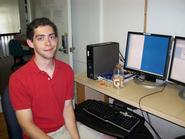
A written assignment can be deceiving. Even if the finished product is immaculate, the student might have put in many hours of work in order to get it to that point. On the other hand, holes in a student’s argument indicate that he either rushed through that portion of his analysis or toiled over its synthesis for longer than necessary. Matt Russell ’11 sees this as a problem for educators who are trying to help their students understand classroom material. If they cannot see what areas on which their students are spending an inordinate amount of time, they cannot help them improve. This summer, Russell worked with Associate Professor of Computer Science Mark Bailey to design a computer program that will visually represent the time spent on certain aspects of computer programming.
In computer science classes, students attend programming sessions. But like writing a paper for an English or sociology class, programming is a process. A computer scientist might stare at his monitor for hours, rewriting and reworking. Although no student will concoct a perfect program the first time around, professors can help students become more efficient if they can see where there was the most revision.
Russell and Bailey are devising a program that will hook up to text editors like Microsoft Word and record keystrokes for the duration of a student’s work period. It will then highlight the parts of the project that took the longest.
Russell first had to find the best way to store information on deleted keys, because a person’s progress consists in not just how much time it takes to successfully get words on the page, but also in how much back-tracking they did. It is difficult to represent deleted words and letters because they are often very spontaneous. Therefore, this part of Russell’s project was the biggest obstacle to overcome.
“If we can make the program, then professors will be able to average out their classes and cross-reference the sections in their programs,” he said. “It would help companies see which ways people think and how they perform.”
His career plans are uncertain, but Russell says he knows the experience this summer will come in handy regardless of whatever path he takes. The opportunity to get published or go to a conference is one that he would not want to miss.
Russell is a graduate of Saint Andrews School.
In computer science classes, students attend programming sessions. But like writing a paper for an English or sociology class, programming is a process. A computer scientist might stare at his monitor for hours, rewriting and reworking. Although no student will concoct a perfect program the first time around, professors can help students become more efficient if they can see where there was the most revision.
Russell and Bailey are devising a program that will hook up to text editors like Microsoft Word and record keystrokes for the duration of a student’s work period. It will then highlight the parts of the project that took the longest.
Russell first had to find the best way to store information on deleted keys, because a person’s progress consists in not just how much time it takes to successfully get words on the page, but also in how much back-tracking they did. It is difficult to represent deleted words and letters because they are often very spontaneous. Therefore, this part of Russell’s project was the biggest obstacle to overcome.
“If we can make the program, then professors will be able to average out their classes and cross-reference the sections in their programs,” he said. “It would help companies see which ways people think and how they perform.”
His career plans are uncertain, but Russell says he knows the experience this summer will come in handy regardless of whatever path he takes. The opportunity to get published or go to a conference is one that he would not want to miss.
Russell is a graduate of Saint Andrews School.
